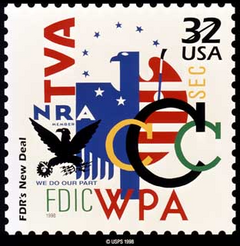Difference between revisions of "Alphabet agencies"
From Conservapedia
DavidB4-bot (Talk | contribs) (→See also: clean up & uniformity) |
|||
| (8 intermediate revisions by one other user not shown) | |||
| Line 1: | Line 1: | ||
| − | |||
[[File:Newdealstamp.png|thumb|240px]] | [[File:Newdealstamp.png|thumb|240px]] | ||
| − | [[ | + | The '''alphabet''' agencies were the [[New Deal]] programs of the 1930s, typically identified by their initials, such as [[AAA]], [[CCC]], NRA, [[NYA]], [[WPA]] and PWA, FDIC, [[TVA]], and many more. |
| + | |||
| + | Many of these agencies which allegedly helped the "poor and needy" were found [[unconstitutional]] and dismantled. However, one such alphabet agency that survived, [[FNMA]] commonly known as Fannie Mae, encouraged greedy evil [[Wall Street]] bankers to get richer faster by purchasing bundles of home mortgages from them to [[stimulus|stimulate]] home sales with federal [[deficit spending]] dollars. It served the dual purpose as a middle class welfare program, creating dependency on government handouts of cheap, subsidized mortgage interest rates for voting constituents who were not so needy. | ||
| + | |||
| + | ==See also== | ||
| + | *[[Democratic party]] | ||
| + | *[[Harry Hopkins]] | ||
| + | *[[Henry A. Wallace]] | ||
| + | |||
| + | |||
| + | |||
| + | [[Category:New Deal]] | ||
Latest revision as of 22:14, June 27, 2016
The alphabet agencies were the New Deal programs of the 1930s, typically identified by their initials, such as AAA, CCC, NRA, NYA, WPA and PWA, FDIC, TVA, and many more.
Many of these agencies which allegedly helped the "poor and needy" were found unconstitutional and dismantled. However, one such alphabet agency that survived, FNMA commonly known as Fannie Mae, encouraged greedy evil Wall Street bankers to get richer faster by purchasing bundles of home mortgages from them to stimulate home sales with federal deficit spending dollars. It served the dual purpose as a middle class welfare program, creating dependency on government handouts of cheap, subsidized mortgage interest rates for voting constituents who were not so needy.
